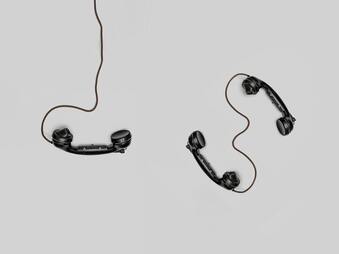 One of the important parts of ISO 9001:2015 can be categorised as one word - communication. We can never be sure that our messages are understood, even when dealing with work colleagues, so think how much harder it is when we talk to other organisations or the general public. The major assumption underlying this session is that all organisations and individuals need to communicate: to impart or exchange information in a meaningful, timely and clear way.
You will no doubt agree that communication is not straightforward. How can you tell whether your understanding matches what was intended? If will depend on a number of factors: the message, the vehicle and the type of person you are. The vehicle or channel that is used to communicate might affect your interpretation of the message. For example, you may expect a suit to be more expensive if it is advertised in an exclusive magazine rather than in a widely distributed newspaper. An experiment a few years ago proved this. Customers were asked to estimate the price of the same dress advertised in two different magazines. Those who were shown the advertisement in an exclusive magazine priced the dress at about 25 per cent more than those who saw it in the lower-priced, less exclusive one. The situation in which a message is sent or received will have an effect as well. While this paragraph may have been written in a sunny study with a view of trees outside the window, you may be reading it on a commuter train after an exhausting day at work: the writer’s attention was focused on the message, your attention may be distracted by the ticket inspector or the headlines in your neighbour's newspaper. What we are beginning to describe here is the classic model of communication. All messages have a sender and a receiver. The sender seeks to transmit the message in such a way that the receiver understands it and acts on it as the sender intended. The sender, therefore, needs to encode the message and send it via a vehicle (the medium of transmission, or channel) so that it can be decoded by the receiver. The aim is for the message ‘as sent’ to be the same as the message ‘as received’, although in practice there will be a lot of noise and distortion. The way a sender encodes a message depends on the content of the message, the abilities and mood of the sender, and the assumptions the sender makes about the receiver. The message may be conveyed using a communication vehicle such as television, the newspaper, radio, e-mail, the Internet and so on. The communication vehicle itself may be carrying lots of other messages - for example advice, information, advertising - much of which will be background noise. The audience will have to decode the message, and whether they do so will depend not only on their abilities but also on the amount of noise surrounding the message. We would expect some response from the audience once they have decoded the message: an expression of satisfaction, a purchase, or a request for more information. If you would like to look at how to implement an ISO 9001 quality management system, then simply contact us. Or, if you want to see what's involved in more detail, then get a completely free, no obligation, totally tailored ISO Gap Analysis for your business (only available to UK businesses).
0 Comments
 Last week we looked at the link between quality and brand performance. This week we look at how customers’ needs change over time, and the way their expectations of products also change. For a brand to be successful, wherever it is sold it must: 1. deliver functional benefits to meet the market need at least as well as the competition does 2. offer intangible benefits over and above the basic benefit of the core product 3. comprise various benefits which are consistent with each other and present a unified character or identity 4. offer special features that customers want, that is, something valued and which customers judge nobody else can offer. Being ozone-friendly or low in cholesterol are features that are appropriate in the 21st century, although they probably would not have sold many products 50 years ago! As a final comment on meeting customers’ needs and wants, we can link together our discussion on product levels, product life-cycles and brands. We have seen that customers’ needs change over time and their expectations of products also change. Needs may change because circumstances change; for example, when a couple have children, they may need a larger car. Consumers’ expectations change as organisations develop and later products and think up new features and benefits which add value to their offering. Customers begin to expect new features as part of the standard offering and look to organisations to provide them. The implication for organisations is that they have to continually develop the products they offer as well as launch new products to fulfil new needs that customers may have. It also means that over time some products are no longer wanted by customers so organisations have to stop providing them and therefore need other products to replace the revenue that they lose. In order to achieve this, organisations need a balance between cash-generating or resource-attracting products (income) and cash- or resource-using ones (expenditure). Organisations cannot sustain a negative cashflow over a long period unless they have substantial reserves and clear objectives for doing so. So a major task for organisations is to decide which products to encourage and develop, continue with, phase down or phase out in order to maintain cashflow. Organisations also need a constant flow of new ideas from which new products will eventually grow and be introduced to the market. In addition to new product ideas, other innovations are necessary:
New product development, then, is an important part of any organisation's activities. It does not happen by chance, but must be planned for and given resources to ensure it happens. A final implication of the constantly changing nature of customers’ needs and expectations is the development of brand names by organisations. This drive is aimed at creating repeat purchasing among customers and, hopefully, loyalty to a particular product. This means that although organisations still need to improve existing products and develop new ones, customers may continue to buy an organisation's products because they trust the quality, and feel an affinity with the brand identity rather than because it always provides the most innovative products. If you would like to look at how to implement an ISO 9001 quality management system, then simply contact us. Or, if you want to see what's involved in more detail, then get a completely free, no obligation, totally tailored ISO Gap Analysis for your business (only available to UK businesses).  Last week we looked at how brands which are well known and trusted can serve as a shortcut for consumers trying to choose between competing offers. This week we look at the link between quality and brand performance. Arnold (1992) says that three important principles have emerged from research into brand performance: 1. Market leaders and superior brand positions are interlinked. Top brands are virtually all leaders, or joint leaders, in their markets. This is not just because the companies spend a lot on advertising or because the brands have a good name or are inherently better quality products. It is the perception of quality by the customer which is important. That perception depends on how the product meets customers’ needs and wants. UNICEF, the children’s charity, is able to encourage donations through a well-established image and a perception that it is meeting customers’ needs - both the children it helps and the people who give their time or money so that the organisation can carry out its objectives. 2. Market-leading brands tend to have higher profit margins. Research shows that market leaders command a price premium and therefore make higher profits. Recent surveys conclude that in the USA the market leader returns a margin four times that of the number two in the market, and in the UK the margin is six times greater. Leading brands also demonstrate greater resilience during recessions or price wars. Perceived superior quality is reflected in consumers’ willingness to pay more. 3. There is no such thing as a brand life-cycle. Once a leading brand is established with a loyal customer base, there is no reason why that position cannot be maintained almost indefinitely. Brands are larger than products. They can be updated regularly and altered in almost any aspect to maintain their relevance to the market. As long as the brand is kept up to date there is no reason why it should not live forever. This does not mean that brands will live forever, just that they may be able to if properly managed and looked after. There are examples of brands which have disappeared or run into trouble. One distinguished brand which has been in existence in the UK since 1894 — Marks & Spencer, a retail store selling clothing, home furnishings and food — went through difficult times in the late 1990s. Brands which have been around for over 60 years and show no signs of disappearing. All purchase decisions involve an element of risk, and buying behaviour shows that the drive for something well-known and trusted is often stronger than the drive for novelty. If you would like to look at how to implement an ISO 9001 quality management system, then simply contact us. Or, if you want to see what's involved in more detail, then get a completely free, no obligation, totally tailored ISO Gap Analysis for your business (only available to UK businesses). |
WelcomeHere you'll find the latest blog articles on all things compliance, particularly focussed on quality, environment, health & safety and information security. Get a completely free, no obligation, totally tailored ISO Gap Analysis for your business...
Categories
All
Archives
April 2024
|
|
Read about our ISO implementation services...
|
Read about our ISO maintenance services...
|
 RSS Feed
RSS Feed


